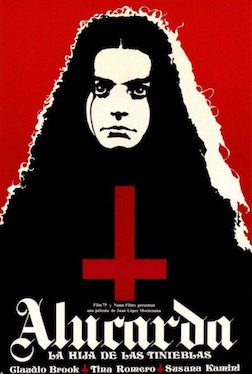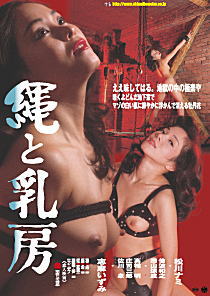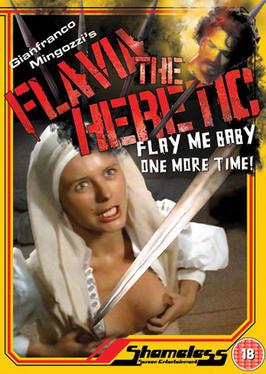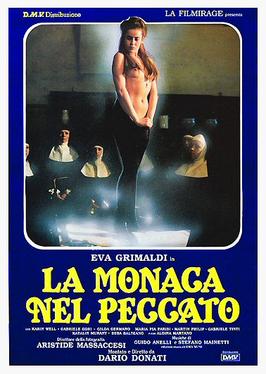
Nunsploitation is a subgenre of exploitation film which had its peak in Europe in the 1970s. These films typically involve Christian nuns living in convents during the Middle Ages.

Nunsploitation is a subgenre of exploitation film which had its peak in Europe in the 1970s. These films typically involve Christian nuns living in convents during the Middle Ages.
The main conflict of the story is usually of a religious or sexual nature, such as religious oppression or sexual suppression due to living in celibacy. The Inquisition is another common theme. These films, although often seen as pure exploitation films, often contain criticism against religion in general and the Catholic Church in particular. Indeed, some protagonist dialogue voiced feminist consciousness and rejection of their subordinated social role. Many of these films were made in countries where the Catholic Church is influential, such as Italy and Spain. One atypical example of the genre, Killer Nun (Suor Omicidi), was set in then present-day Italy (1978).
Nunsploitation, along with nazisploitation, is a subgenre that ran a parallel course alongside women in prison films in the 1970s and 1980s. As with prison films, they are set in isolated, fortress-like convents where the all-female population turns to lesbianism and perversity. The element of religious guilt allows for lurid depictions of "mortifying the flesh" such as self-flagellation and painful, masochistic rituals. The mother superior is usually a cruel and corrupt warden-like martinet who enforces strict discipline (more opportunities for whippings and medieval-style punishments) and often lusts after her female charges. An equally sadistic and lecherous priest is often included to add an element of masculine menace to the story.
Some segments from the Scandinavian silent film Häxan (1922) may be seen as a precursor for this genre. A recent act of cinematic nunsploitation is in Robert Rodriguez's Machete (2010), where Lindsay Lohan portrays a gun-toting nun. [1] An even more recent example is Darren Lynn Bousman's nunsploitation horror film St. Agatha (2018). [2]
Among other examples of European exploitation cinema over the last sixty years, nunsploitation genre movies are discussed in Mendik and Mathij's recent overview volume on this general trend within regional cinema genres, cultures, and audience consumption. Chris Fujiwara penned a detailed piece in American pop culture journal Hermenaut, discussing genre examples, such as Killer Nun (1978), The Nun and the Devil (1973) and Flavia the Heretic (1974).
Some films, such as the X-rated The Devils , based on a book by Aldous Huxley and directed by Ken Russell, have some basis in fact. Huxley based his original historical account, The Devils of Loudun , on a reported case of mass hysteria and demonic possession that allegedly took place at a French convent in the seventeenth century. Given that the genre was the product of the sixties and seventies, with an occasional contemporary example like the recent Sacred Flesh (1999), there has been little further resort to possible historical source material, like Aelred of Hexham (1110–1167) and his account of the Nun of Watton, for example. Another example might be the life of sister Benedetta Carlini, a 17th-century Italian lesbian nun.
Circa 1986, Graciela Daichman collected stories about aberrant medieval religious women, [3] but since that time, there has been few other serious historical attempt to explore what factual basis might exist for the literary depictions that often served as the basis for nunsploitation cinema. In 2010, Craig Monson wrote Nuns Behaving Badly, which dealt with the social and sexual lives of religious women in sixteenth- and seventeenth-century Italy, but such work remains rare. [4] However, recent work on the dramaturgy of demonic possession in medieval Europe may be useful to comprehend the social, psychological and behavioural context of such acts. [5]
Catholic nun exploitation films have been a subgenre of Japanese exploitation film since at least the early 1970s. Though Christianity was never a dominant religion in Japan, Japan did encounter Christian missionaries. By taking a minority religion as their subject, it has been suggested that these "shockingly perverse and wildly blasphemous" Catholic nun films are "a way of thumbing one's nose at organized religion without attacking the more sacred beliefs of the general society". [6] Some entries in this genre include Norifumi Suzuki's School of the Holy Beast (1974), Masaru Konuma's Cloistered Nun: Runa's Confession (1976), Kōyū Ohara's Sins of Sister Lucia (1978), and Wet Rope Confession: Convent Story (1979), Hiroshi Mukai's Nun: Secret (1978), Nobuaki Shirai's Nun Story: Frustration in Black (1980), and Mamoru Watanabe's Rope of Hell: A Nun's Story (1981) and Electric Bible: Sister Hunting (1992). [7] In 1995, big-busted AV idol Mariko Morikawa starred in director Sachi Hamano's Big Tit Monastery (巨乳修道院), another Japanese variation on the nunsploitation genre. [8]
Toronto-based stage artist Jamieson Child, directed in 2015 the stage musical Kill Sister, Kill: A Dark New Musical, as homage to the exploitation genre. [9]

An exploitation film is a film that tries to succeed financially by exploiting current trends, niche genres, or lurid content. Exploitation films are generally low-quality "B movies", though some set trends, attract critical attention, become historically important, and even gain a cult following.
Pink film theater in Gifu
The women in prison film is a subgenre of exploitation film that began in the early 20th century and continues to the present day.

Killer Nun is a 1979 Italian nunsploitation horror film directed and co-written by Giulio Berruti, co-written by Alberto Tarallo, and starring Anita Ekberg, Joe Dallesandro, Lou Castel, and Alida Valli. Its plot follows a nun who, after recovering from brain surgery, grows increasingly paranoid that her health is again declining; she begins indulging in opioids from the hospital in which she works, and spirals into addiction and madness with violent consequences. The film is loosely based on the true story of a Cécile Bombeek, a middle-aged nun who committed a series of murders in a geriatric hospital in Wetteren, Belgium in 1977.

The Nun and the Devil is an erotic 1973 Italian nunsploitation film directed by Domenico Paolella. It is also known as: Sisters of Satan (UK) and The Nuns of Saint Archangel (US). The action is set in the 16th century at the convent of Sant Arcangelo, near Naples, then under Spanish rule. The success of the film resulted in another period drama/nunsploitation film by Paolella released the same year, Story of a Cloistered Nun, an Italian/French/West German co-production starring Eleonora Giorgi.
Masaru Konuma was a Japanese film director known for his Roman Porno films for Nikkatsu during the 1970s.
Kōyū Ohara was a Japanese film director known for his popular Roman Porno films, Fairy in a Cage (1977) and the Pink Tush Girl series (1978–1980). One of Nikkatsu's most versatile and prolific directors, filming eight movies in 1979 alone, his stylistic preoccupations led him to be known as "King of Pop Art Porn."

Cloistered Nun: Runa's Confession (1976) is a Japanese pink film in the nunsploitation genre starring pop singer Luna Takamura, directed by Masaru Konuma and produced by Nikkatsu. AllRovi reports of the film, "As Konuma is not one to pull political punches for the sake of lightweight erotic fluff, the film is far more pointed than the numerous European 'sexy nun' films it ostensibly resembles." Jasper Sharp calls it "a typically profane offering in the most peculiar of Nikkatsu's pornographic subgenres".
Judith C. Brown is an American historian and a Professor Emerita of History at Wesleyan University. A specialist on the Italian Renaissance, she is considered a pioneer in the study of the history of sexuality whose work explored the earliest recorded examples of lesbian relationships in European history.

Images in a Convent is a 1979 sexploitation film by Italian cult filmmaker Joe D'Amato starring Paola Senatore, Marina Hedman and Donald O'Brien.

Alucarda is a 1977 English-language Mexican supernatural horror film directed by Juan López Moctezuma, and starring Tina Romero, Claudio Brook, Susana Kamini, and David Silva. A loose adaptation of Carmilla (1872), it revolves around two teenage orphan girls living in a Catholic convent, who unleash a demonic force and become possessed.

Rope and Breasts is a 1983 Japanese film in Nikkatsu's Roman porno series, directed by Masaru Konuma and starring Nami Matsukawa.
Luna Takamura or Runa Takamura was a J-pop singer, actress and dancer of Japanese and German descent. Later in her career, she became particularly known for her two Nikkatsu Roman Porno films released in 1976.

Satánico pandemonium is a 1975 Mexican nunsploitation horror film directed by Gilberto Martínez Solares and written by Jorge Barragán, Adolfo Martínez Solares and Gilberto Martínez Solares. It stars Cecilia Pezet, Enrique Rocha and Delia Magaña.

Flavia the Heretic is a 1974 Italian-French nunsploitation film directed by Gianfranco Mingozzi.

Story of a Cloistered Nun is a 1973 nunsploitation film directed by Domenico Paolella and starring Eleonora Giorgi, Catherine Spaak, Suzy Kendall, Martine Brochard, Tino Carraro, and Umberto Orsini. The film claims to be inspired by real events that occurred in the 16th-century at the Certosa di San Giacomo.

Devils of Monza is a 1987 Italian historical erotic-drama film directed by Luciano Odorisio. It is based on real-life events related to Marianna de Leyva, better known as Sister Virginia Maria, "The Nun of Monza", whose story was made famous by Alessandro Manzoni's novel The Betrothed.

The Other Hell is a 1981 Italian horror film written and directed by Bruno Mattei and Claudio Fragasso and starring Franca Stoppi and Carlo De Mejo.

Convent of Sinners, is a 1986 Italian nunsploitation erotic film directed by Joe D'Amato. D'Amato directed, photographed and edited the film. The Rene Rivet screenplay was based on the novel "La Religeuse" by Denis Diderot.

Immaculate is a 2024 American psychological horror film directed by Michael Mohan, written by Andrew Lobel, and co-produced by Sydney Sweeney, who also stars in the film alongside Álvaro Morte, Benedetta Porcaroli, Dora Romano, Giorgio Colangeli, and Simona Tabasco. The plot focuses on a young woman of devout faith, who is invited to reside at a picturesque Italian convent, but slowly realizes the terrifying secrets it harbors.